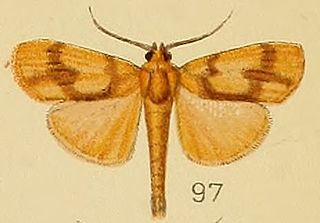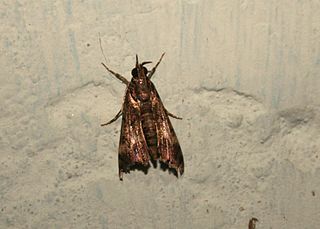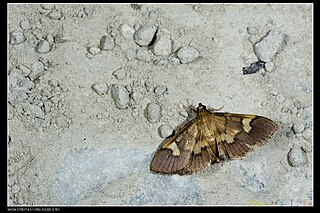
Circobotys is a genus of moths of the family Crambidae.

Cirrhochrista is a genus of moths of the family Crambidae described by Julius Lederer in 1863.

Ulopeza is a genus of moths of the family Crambidae. It was described by Philipp Christoph Zeller in 1852.

Parotis is a genus of moths of the family Crambidae.

Sufetula is a genus of moths of the family Crambidae.

Glyphodes negatalis, the karanj defoliator, is a moth of the family Crambidae. The species was first described by Francis Walker in 1859. It has a wide range in the tropics, including South Africa, The Gambia, Mali, India, Sri Lanka, Hong Kong, Japan, and eastern Australia.
Circobotys elegans is a moth in the family Crambidae. It was described by Eugene G. Munroe and Akira Mutuura in 1969. It is found in Taiwan.

Bradina admixtalis is a species of moth of the family Crambidae described by Francis Walker in 1859. It is found in Australia, New Guinea, New Zealand, south-east Asia and the Comoros, Réunion, South Africa as well as India.
Loryma athalialis is a species of snout moth in the genus Loryma. It was described by Francis Walker in 1859 and is known from the Democratic Republic of the Congo, South Africa and Madagascar.

Orphanostigma abruptalis is a moth of the family Crambidae. The species was first described by Francis Walker in 1859. It occurs in the tropics of the Old World from Africa to Australia.

Noorda blitealis is a species of moth of the family Crambidae. It is found in subtropical Africa, south of the Sahara and in Australasia.

Circobotys flaviciliata is a moth in the family Crambidae. It was described by George Hampson in 1910. It is found in the Democratic Republic of the Congo.
Crocidophora caffralis is a moth in the family Crambidae. It was described by George Hampson in 1910. It is found on Mayotte and in South Africa, Zambia and Zimbabwe.
Mecyna procillusalis is a moth in the family Crambidae. It was described by Francis Walker in 1859. It is found in South Africa.
Diasemia accalis is a moth in the family Crambidae. It was described by Francis Walker in 1859. It is found in Sumatra, Indonesia, China, the north-western Himalayas, Myanmar, Malaysia, Taiwan, Korea, Japan, the Democratic Republic of the Congo and Rwanda.
Dolicharthria mabillealis is a moth in the family Crambidae. It was described by Viette in 1953. It is found in Madagascar.

Glyphodes pyloalis, the lesser mulberry snout moth, lesser mulberry pyralid or beautiful glyphodes moth, is a moth in the family Crambidae. It was described by Francis Walker in 1859. It is found in Iran, China, Japan, India, Indonesia (Sumatra), Sri Lanka, Taiwan, the Democratic Republic of the Congo, Equatorial Guinea, Mozambique and North America, where it has been recorded from Florida, Maryland, North Carolina, South Carolina and Virginia.

Nacoleia charesalis is a moth in the family Crambidae. It was described by Francis Walker in 1859. It is found in Australia, India, Sri Lanka, Borneo, Sumbawa, the Philippines, Singapore, Thailand, Japan, Taiwan and on the Seychelles.

Ischnurges gratiosalis is a moth in the family Crambidae. It was described by Francis Walker in 1859. It is found in Sri Lanka, China, Taiwan and India and on Borneo and the Maldives.

Syngamia falsidicalis is a moth in the family Crambidae. It was described by Francis Walker in 1859. It is found in the Democratic Republic of the Congo (Equateur), Zimbabwe, China, Sri Lanka and Taiwan.












